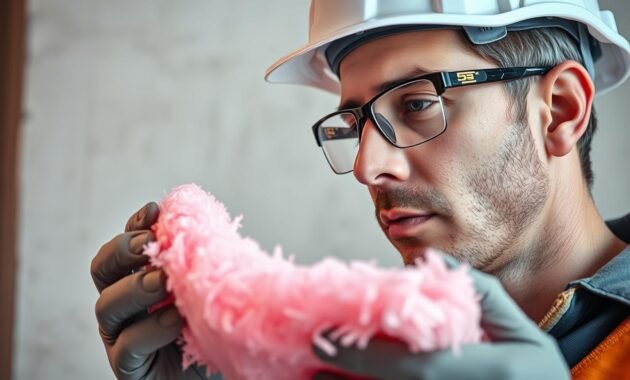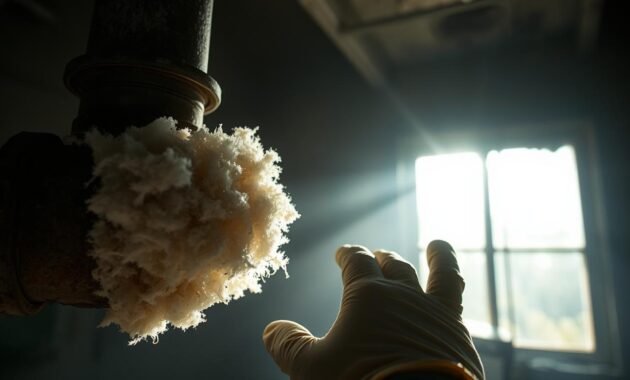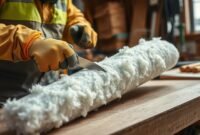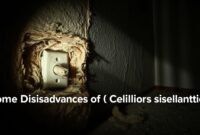Are you worried about hidden dangers in your walls? Many homeowners fear their insulation might contain deadly asbestos. Seeing pink insulation can make you anxious about health risks.
What if the insulation you trusted could be silently harming your family’s health?
Don’t worry. Modern pink fiberglass insulation is completely asbestos-free. I’ll help you understand the materials in your home. We’ll debunk myths about insulation safety and guide you in making smart choices for your living space.

Understanding Asbestos in Home Insulation Materials
Asbestos was once a miracle material in construction, known for its fire resistance and durability. In the mid-20th century, it became a key part of building materials, including home insulation.
Historical Use of Asbestos in Construction
Asbestos has a rich history in construction. From the 1930s to the 1970s, it was widely used without much concern. Its unique properties made it a favorite among contractors.
- Widespread use in residential and commercial buildings
- Incorporated into insulation, roofing, and flooring
- Considered a cost-effective and reliable material
Why Asbestos Was Popular in Insulation
Asbestos was popular for its fire resistance. It was perfect for insulation, protecting homes from fires. Its ability to withstand high temperatures made it a top choice for thermal protection.
| Asbestos Property | Benefit in Construction |
|---|---|
| Fire Resistance | Extremely high heat tolerance |
| Thermal Insulation | Excellent temperature regulation |
| Durability | Long-lasting material |
The Ban on Asbestos Products
As health risks were discovered, asbestos use declined. Government rules started to limit its use in construction. By the late 1980s, health concerns led to bans and removal efforts.
- EPA regulations limited asbestos use
- Health concerns prompted industry changes
- Alternative insulation materials developed
Knowing this history is key for homeowners. It shows why professional asbestos testing and safe insulation practices are so important.
Read also: Is Cellulose Insulation Safe?
Does Pink Insulation Have Asbestos?
Many homeowners worry about asbestos in home insulation. Let’s clear up some myths about pink insulation. The color of insulation doesn’t tell you if it has asbestos, thanks to modern materials.

Pink insulation is usually made from fiberglass, which is asbestos-free. Today’s insulation makers use safe materials instead of harmful ones. The old gray brown insulation was risky, but pink insulation is safe now.
- Fiberglass is the primary material in pink insulation
- Modern insulation is made without asbestos
- Color doesn’t mean insulation is safe
To make sure your insulation is safe, follow these steps:
- Check when your insulation was made
- Make sure it’s made of safe materials
- Get a pro’s help if you’re unsure
| Insulation Type | Asbestos Risk | Modern Safety |
|---|---|---|
| Pink Fiberglass | No Risk | Fully Compliant |
| Gray Brown Loose Fill | High Risk | Outdated |
If you’re not sure about your insulation, get it tested. Modern pink insulation is safe and works well. It keeps your home safe from the dangers of old insulation.
Common Types of Insulation Materials Today
Home insulation has changed a lot from the old days. Now, we have safer, better, and greener options. Let’s look at the top picks for home insulation today.
The market offers many insulation types to keep your home cozy and save energy. We’ll check out the best choices that have replaced old, risky materials.
Read also: Different Types of Blown In Insulation for Your Home
Fiberglass Insulation
Fiberglass is the most used insulation in homes. It’s cheap, light, and works well to stop heat from moving. You might know it by its pink or yellow color, seen in many stores.
Cellulose and Natural Fiber Options
People who care about the planet are choosing recycled paper insulation. Cellulose, made from recycled paper, is great for keeping warm and is eco-friendly. Natural fibers like cotton and wool are also popular for being green.
Modern Synthetic Alternatives
Rock wool is a top pick for synthetic insulation. It’s good at fighting fires and blocking sound. Plus, it’s made from recycled stuff and keeps your home warm better than old types.
| Insulation Type | Key Benefits | Environmental Impact |
|---|---|---|
| Fiberglass | Low cost, easy installation | Moderate recycling |
| Cellulose | Made from recycled paper | High eco-friendly rating |
| Rock Wool | Fire resistant, sound dampening | Good recycling |
When picking insulation, think about your home’s needs, budget, and how green you want it to be. Each type has its own benefits. So, do your homework to find the best fit for you.
Identifying Asbestos-Containing Insulation

As a homeowner, spotting asbestos in your insulation can be hard. The Environmental Protection Agency says to check older homes carefully. This is true for attic floors, where harmful materials might be hidden. Knowing what asbestos insulation looks like is key to staying safe.
Asbestos insulation can show up in a few ways:
- It looks like fluffy wool
- It’s hard, like corrugated cardboard
- It has a pebbly or granular feel
- It’s usually gray, gray-brown, or silvery gold
When you look at attic floors, watch for these signs. Homes built before the 1980s might have asbestos insulation. The Environmental Protection Agency warns against trying to test or remove it yourself because it’s risky.
Getting a professional to test for asbestos is the best way. Experts can safely take samples and tell you for sure if it’s there. This keeps you and your family safe from harm.
Here are some signs that might mean you have asbestos insulation:
- Insulation that’s over 30 years old
- Crumbly or damaged insulation
- Unusual texture or color in attic spaces
- Visible damage to insulation materials
If you’re unsure, always ask a professional. Your health and safety are the most important things when dealing with asbestos.
Health Risks Associated with Asbestos Exposure
Asbestos exposure can cause serious health problems. It’s important to know these risks to protect yourself and your family.
Asbestos fibers in the air can lead to severe lung issues. Lung cancer and mesothelioma are major risks. These diseases can take years to show up after exposure.
Mesothelioma: A Deadly Lung Cancer
Mesothelioma is a rare but aggressive cancer caused by asbestos. It mainly affects the lungs and chest area. Workers in construction, shipbuilding, and manufacturing are at high risk.
- Primary cause: Direct asbestos fiber inhalation
- Latency period: 20-50 years after exposure
- Typically diagnosed in later stages
Respiratory Complications
Asbestos exposure can also lead to other lung problems. Asbestosis is a chronic disease that makes breathing hard and gets worse over time.
| Health Condition | Primary Symptoms | Risk Level |
|---|---|---|
| Mesothelioma | Chest pain, shortness of breath | Extremely High |
| Lung Cancer | Persistent coughing, weight loss | High |
| Asbestosis | Breathing difficulties, crackling sounds | Moderate to High |
If you think you’ve been exposed to asbestos, see a doctor. Early diagnosis can help treat lung cancer and mesothelioma better.
Professional Asbestos Testing and Detection Methods
Asbestos testing is a serious matter that requires professional help. It’s important to hire certified experts who know how to find asbestos in buildings. Trying to test for asbestos yourself can be dangerous and might expose you to harmful fibers.
Professional asbestos testing includes several key steps:
- Visual inspection by trained experts
- Sample collection using specialized equipment
- Laboratory analysis with advanced microscopic techniques
- Comprehensive reporting of findings
Experts will take small samples from areas they think might have asbestos. These samples are then checked in labs using special tools. Polarized Light Microscopy (PLM) and Transmission Electron Microscopy (TEM) are used to find asbestos accurately.
The cost of asbestos testing can be between $250 and $750. This depends on your property’s size and how many samples are needed. It’s a small price to pay for keeping your family safe from asbestos.
Only experts can say for sure if there’s asbestos. Don’t try to collect samples or check for asbestos yourself.
Safe Removal and Disposal of Asbestos Insulation
Discovering asbestos in your home can be overwhelming. The environmental protection agency advises taking quick and careful steps to protect your health and property. It’s best to hire professionals for safe removal.
Choosing Licensed Asbestos Removal Contractors
When picking a professional for asbestos removal, it’s important to do your homework. The environmental protection agency offers tips for finding the right experts:
- Verify state and federal certifications
- Check professional licensing credentials
- Request detailed removal and disposal plans
- Confirm they have full insurance coverage
Legal Requirements and Safety Protocols
Asbestos removal is strictly regulated to keep everyone safe. Here are the main safety rules:
| Requirement | Details |
|---|---|
| Notification | Submit removal plans to local authorities |
| Personal Protection | Advanced respirators and protective suits are a must |
| Containment | Sealed work areas with negative air pressure |
| Disposal | Specialized hazardous waste transportation |
Following environmental protection agency guidelines is key during asbestos removal. DIY removal can be very dangerous. Always choose professional help for your safety.
Alternative Safe Insulation Options for Modern Homes
Choosing the right insulation is key to protecting your home. Modern homes have many safe insulation options. These options are better than older materials and offer great comfort and energy savings.
Fiberglass is a top pick for insulation. It comes in two main forms:
- Batt or blanket insulation (the familiar pink rolls)
- Loose-fill fiberglass for hard-to-reach spaces
Recycled paper insulation is also popular. It’s made from recycled paper and is eco-friendly. This insulation is treated to be safe and energy-efficient.
Rock wool insulation is another great choice. It’s made from natural stone and is fire-resistant. It also blocks sound well, making it a great choice for homes.
Here’s a quick comparison of modern insulation options:
| Insulation Type | Energy Efficiency | Environmental Impact |
|---|---|---|
| Fiberglass | High | Moderate |
| Recycled Paper (Cellulose) | High | Low |
| Rock Wool | Very High | Moderate |
When picking insulation, think about your climate, home design, and budget. Each insulation type has its own benefits. Talking to a professional can help you choose the best one for your home.
Conclusion
Understanding home insulation can seem tough, but knowing your options is key to keeping your family safe. Modern blown in insulation is safer and more efficient than older types. It’s important to know what’s in your walls and make smart choices about home care.
Fire safety is now a big deal when picking insulation. Materials like fiberglass and cellulose are safer and better than asbestos. Always choose safe, professional options when improving your home.
Be careful when updating older homes. If you think there’s asbestos, get it checked by experts. New insulation technologies make homes safer and more energy-efficient.
Keeping your home safe is a continuous effort. Stay updated, talk to experts, and always put your family’s safety first. Making smart insulation choices is essential for your family’s health and comfort.


